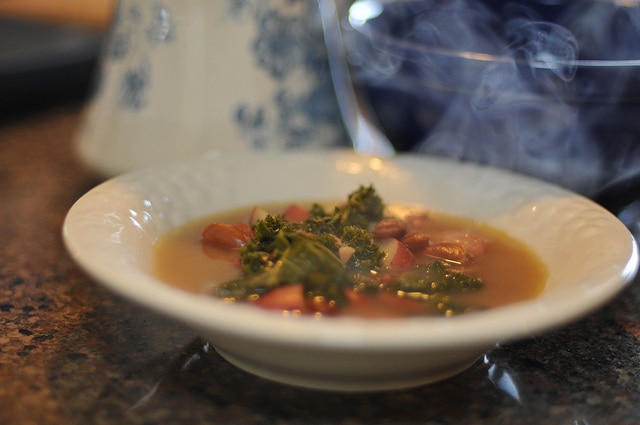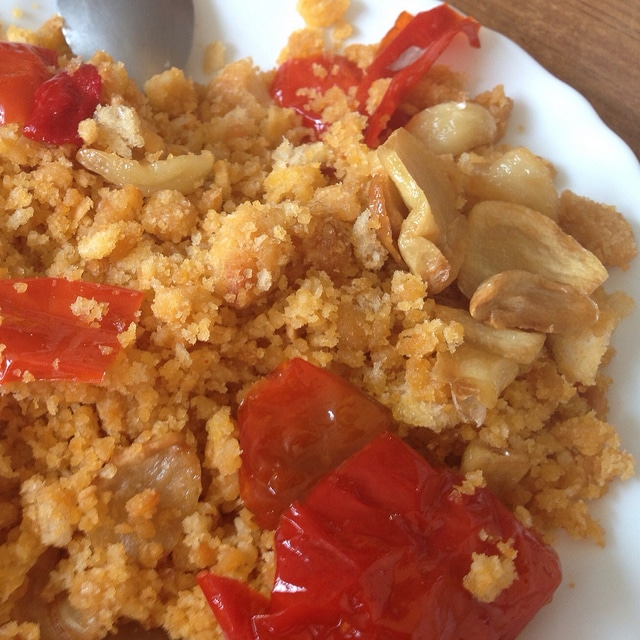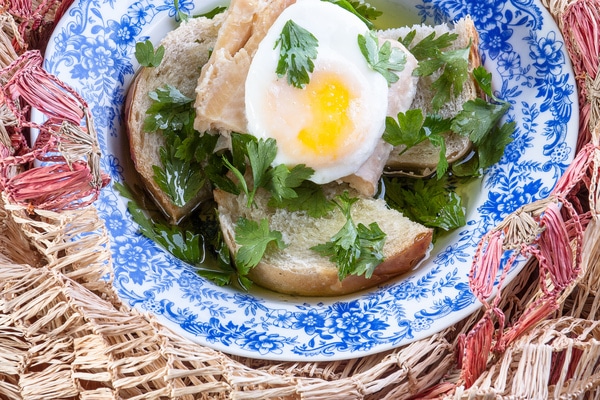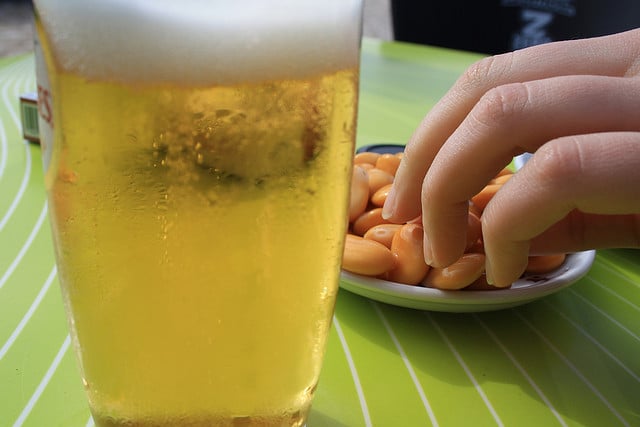Hold The Pork: Vegetarian-Friendly Finds In Portugal's Land Of Meat And Fish

Fishing boats in Portugal. Photo courtesy of Fotografar.
Traveling to Portugal, the world's fourth highest fish consumer per capita and a land of avid meat-eaters, can be intimidating for vegetarians like myself. Asking around for meat-free dishes, I received responses like "Cozinha vegetariana? Uhhh... I don't think we have that" from people whose eyes bulged at even the idea of an omnivore diet.
Although most Portuguese think more is better when it comes to meat—it's not uncommon to find beef, pork, salt pork, pigs feet and more packed into a single dish, as in cozido à portuguesa, a stew that can include up to a half-dozen varieties of meat with vegetables—Portuguese food isn't intrinsically anti-vegetarian.
Traditionally, Portuguese have concocted simple, hearty soups, stews and other dishes featuring regional ingredients, including vegetables such as green beans, peas, potatoes, cabbages, cauliflower, broccoli, carrots and kale. Historically, high prices of meat and fish meant peasants tended to cook without these protein sources. Rural peasant cooking inspired many of the vegetarian dishes recommended below. Today, meat and seafood take center stage, since Portugal's seaside location supports the high availability of fresh fish as well as rabbit, wild game, cow, pig, sheep and goat.
Dishes often showcase spices from the colonies Portugal ruled, including piri piri (fiery chili peppers), black peppers, saffron, vanilla and cinnamon. Generous usage of garlic, olive oil and herbs create meaty, starchy dishes that, unfortunately for vegetarians, rarely highlight vegetables as the main feature. In major cities like Porto and Lisbon it's possible to find all-vegetarian restaurants, if you are willing to eat Indian, Mexican or other ethnic cuisines; however, finding meat-free traditional dishes even challenged my food-loving local guides.
After extensive investigating, I found several soups, snacks and meals that capture the essence of local cuisine while offerings vegetarian-friendly Portuguese food. Carnivores and pescatarians, keep reading, since many chefs tend to enhance dishes with protein unless you specify otherwise. Even if you're not in Portugal you can cook up some of these simple, hearty dishes in your own kitchen for a cultural culinary adventure. And if you're a vegetarian and find yourself at a restaurant that offers these dishes, ask chefs for meat-free versions — hospitable Portuguese often go out of their way to accommodate requests.
Note: Strict vegetarians should be wary that soup and vegetables are commonly cooked in fish or chicken stock and pastries can contain animal fat.

Caldo Verde, Portugal's signature soup. Photo courtesy of Quoi Media.
1) Caldo Verde
Portuguese often serve soups as precursors to the main meal or as a late supper, the majority of which are vegetarian. The "green broth" transforms simple ingredients into something extraordinary in what many consider the country's national dish. This healthy and hearty soup combines potatoes, collard/kale, olive oil, onion, garlic and salt into a surprisingly flavorful dish. Many chefs add linguica or chourico sausage toward the end of cooking, but vegetarians can skip this step (or ask the chef to).
Whether the weather's hot or cold, the Portuguese love their soup, and this easy-to-prepare dish regularly makes an appearance all year round. For a main meal, enjoy your soup with broa, a traditional cornbread introduced to Portugal by whalers and fishermen sailing from the New England coast. The Portuguese often serve caldo verde at celebrations such as weddings, birthdays and the St. John party in Porto every June.

Migas. Photo courtesy of Spanianytt.
2) Migas
Broa takes another form in migas, literally translated as breadcrumbs. This bread soup is prepared by cutting tough, heavy country bread into small pieces, sprinkling them with water and pan-frying with olive oil and garlic to create crunchy, flavorful breadcrumbs. The base of this stew and other ingredients varies regionally. Centrally located Beira tends to use a cornbread base with cooked kale, beans and rice. The Southern Alentejo region uses a wheat breadcrumb base with wild asparagus, tomato, red pepper paste, fresh coriander and pork meat drippings. Potatoes replace breadcrumbs in Alentejo's Migas de Batata.
Peasants ate migas for breakfast as a creative way to repurpose leftover bread. Today, you can find up-scale, reinvented versions of homely fare, usually served as a side dish at restaurants around the globe. That being said, Tex-Mex cuisine has a different take altogether on migas, where strips of corn tortillas are served with scrambled eggs, diced tomatoes, chiles, cheese and tomatoes. Although delicious, the migas you may munch on in Austin, Texas is quite different than the Portuguese version.

Acorda. Photo courtesy of Laetiphotos.
3) Acorda
Like migas, acorda creatively transforms leftover bread, this time into a creamy stew with a risotto-like consistency. Peasant bread is boiled with garlic, coriander, olive oil, white wine and salt until it forms a lumpy porridge. Often served with beans or vegetables, you can find acorda all over the country. Some people prepare acorda in a fragrant fish broth, tossing the boiled bread with fresh chopped parsley and gambas (shrimp) — although if you're a vegetarian you can leave this step out — and stirring in a raw, cracked egg immediately before serving. For a refreshing experience, pair this coastal dish with a crisp regional vinho verde. "Green wine" derives its name from the youthful, fresh grapes that can give the dry, light wine a faint greenish hue.
4) Portuguese "Orange" Soups
In contrast to caldo verde, many fall/winter soups feature an orange base. Chefs can chose from pureed carrot, pumpkin, potato and onion as a base to form a thick, orange soup. Often roasted garlic and sweet sautéed onions compliment the "sweet" richness of the squash. To build upon the base, add the namesake-cooked greens such as nabiças (kale), espinafres (spinach), feijão verde (long green string beans) or couve (cabbage) and feijão (kidney beans).

Tremocos with beer. Photo courtesy of Blue Shoe.
5) Tremoços
These big, butter beans are Portugal's salted peanut, often complimentary with your beer purchase. As to not embarrass yourself in front of your friends at the bar, pop the bean out of its bitter skin and only eat the inside.
Tremoços is Portuguese for lupini beans, a popular snack since Roman times 2,500 years ago when Hippocrates toasted their health benefits. You don't need to go to the pub to munch on tremoços- find them in tubs, jars and huge vacuum seal packets at almost any Portuguese market.

Quijadas/pastéis de feijão with black beans and coconut. Photo courtesy of Anamnesiss.
6) Quijadas/pastéis de feijão
In Portugal, the omnipresent bakeries often overshadow the availability of restaurants. Choosing just one to feature, from the land of pastry lovers, is a challenge but many consider this 19th century "bean patisserie cake" as the country's quintessential dessert. Developed in the city of Torres Vedras, a slightly odd-looking cake contains creamy, phenomenal flavor. With endless variations, this savory, buttery dessert can feature white or red bean puree in an egg-y filling. The doughy dessert is baked to golden brown, sprinkled with powdered sugar and sometimes topped with almonds. Try it at teatime with an energizing cup of Earl Grey or a shot of espresso.
Which of the above-mentioned Portuguese dishes would you go vegetarian food? Have another vegetarian food favorite you sampled in Portugal? Please share in the comments below.
Also Check Out:
Sommelier Certification: How To Truly Appreciate (And Understand) Champagne
Do You Want To Make Money Traveling The World?
Northern And Southern Rhone: Two Very Different Wine Worlds
The post Hold The Pork: Vegetarian-Friendly Finds In Portugal's Land Of Meat And Fish appeared first on Epicure & Culture.